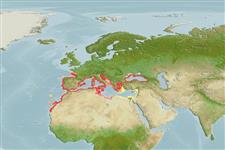Environment: milieu / climate zone / depth range / distribution range
ນິເວດວິທະຍາ
ສັດທະເລ ອາໄສຢູ່ໃກ້ໜ້າດິນໃຕ້ພື້ນທ້ອງນ້ຳ; ລະດັບຄວາມເລິກ 0 - 120 m (Ref. 122887). Subtropical; 50°N - 10°N, 18°W - 42°E
Eastern Atlantic and Mediterranean Sea: including the Adriatic, Aegean and Black Sea, Portugal and Senegal. Has also been reported from southern Morocco, Mauritania, and Angola (Ref. 10813).
ຂະໜາດ / ນ້ຳໜັກ / Age
Maturity: Lm ? range ? - ? cm
Max length : 17.0 cm TL ຕົວຜູ້/ບໍ່ມີເພດ; (Ref. 3397); common length : 12.5 cm TL ຕົວຜູ້/ບໍ່ມີເພດ; (Ref. 3397)
ຄີ (ໜາມ)ແຂງຢູ່ຫຼັງປາ (ທັງໝົດ): 0; ຄີຫຼັງຂອງປາ (ຄີອ່ອນ) (ທັງໝົດ): 53-59; ຄີກົ້ນຂອງປາ: 27 - 32; ສັດທີ່ມີກະດູກສັນຫຼັງ: 64 - 68. Ventrolateral skin-folds extending well beyond pectoral fins to anus. Lateral line branched. Back golden brown or greenish, belly silvery, head usually dark blue.
Found over shell-gravel and coarse sand bottoms (Ref. 6450). Minimum depth from Ref. 122877.
Life cycle and mating behavior
ການຈະເລີນເຕັມໄວ | ການສືບພັນ | ການວາງໄຂ່ | ໄຂ່ | ຄວາມດົກຂອງໄຂ່ປາ | ຕົວອ່ອນ
Quéro, J.-C., 1990. Ammodytidae. p. 920. In J. C. Quéro, J. C. Hureau, C. Karrer, A. Post and L. Saldanha (eds.) Check-list of the fishes of the eastern tropical Atlantic (CLOFETA). JNICT, Lisbon; SEI, Paris; and UNESCO, Paris. Vol. 2. (Ref. 10813)
IUCN Red List Status (Ref. 130435)
Threat to humans
Harmless
Human uses
ການປະມົງ: ເປັນສີນຄ້າ
ຂໍ້ມູນຕື່ມອີກ
ເອກະສານອ້າງອີງການລ້ຽງສັດນ້ຳຂໍ້ມູນການລ້ຽງສັດນ້ຳສາຍພັນກຳມະພັນElectrophoresesການຖ່າຍທອດທາງກຳມະພັນຈາກພໍ່ແມ່ຫາລູກພະຍາດການປຸງແຕ່ງNutrientsMass conversion
ຜູ້ຮ່ວມມືຮູບStamps, Coins Misc.ສຽງຫອຍມີພິດຊະນິດນຶ່ງທີ່ອາໄສໃນທະເລຄວາມໄວປະເພດການລອຍເນື້ອທີ່ເຫືອກOtolithsສະໝອງວິໄສທັດ
ເຄື່ອງມື
Special reports
Download XML
ແຫຼ່ງອີນເຕີເນັດ
Estimates based on models
Preferred temperature (Ref.
123201): 7.8 - 18.1, mean 14.3 °C (based on 57 cells).
Phylogenetic diversity index (Ref.
82804): PD
50 = 0.6250 [Uniqueness, from 0.5 = low to 2.0 = high].
Bayesian length-weight: a=0.00102 (0.00046 - 0.00225), b=3.06 (2.88 - 3.24), in cm total length, based on all LWR estimates for this body shape (Ref.
93245).
ຊັ້ນເຂດຮ້ອນ (Ref.
69278): 3.4 ±0.45 se; based on food items.
ຄວາມຢືດຢຸ່ນ (Ref.
120179): ສູງ, ປະຊາກອນຕຳ່ສຸດທີ່ໃຊ້ເວລາສອງໜ້ອຍກວ່າ 15 ເດືອນ (Preliminary K or Fecundity.).
Fishing Vulnerability (Ref.
59153): Low vulnerability (10 of 100).
Nutrients (Ref.
124155): Calcium = 164 [94, 345] mg/100g; Iron = 1.41 [0.85, 2.56] mg/100g; Protein = 18.6 [16.8, 20.5] %; Omega3 = 0.267 [0.154, 0.459] g/100g; Selenium = 25.7 [12.4, 53.8] μg/100g; VitaminA = 26.8 [8.7, 82.0] μg/100g; Zinc = 0.969 [0.664, 1.406] mg/100g (wet weight);
